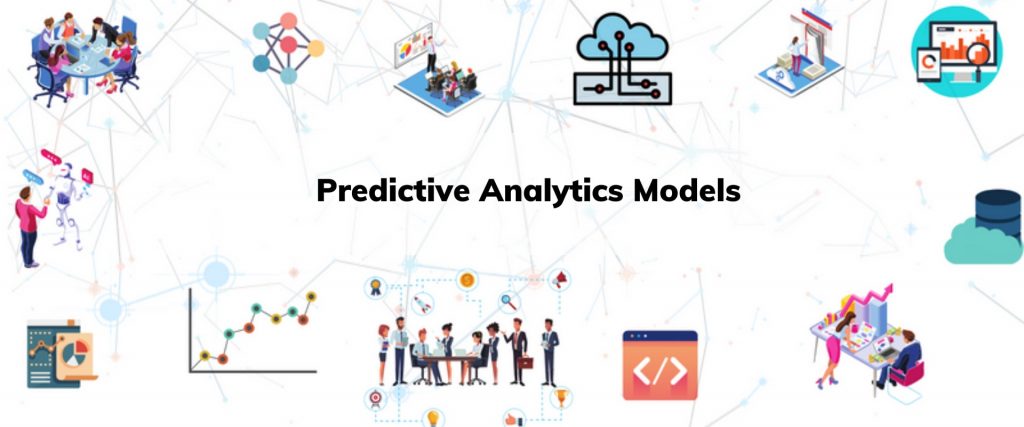Index
- What is Predictive Modeling?
- What are Predictive Analytics Models?
- Types of Predictive Models
- How do predictive analytics models work?
- Summary
What is Predictive Modeling?
Predictive Modeling uses statistical techniques to predict the future behavior/outcome of a model. though In predictive modeling, we often want to predict the outcomes of a future event. However, it applies to any unknown event, irrespective of when it occurred.
What are Predictive Analytics Models?
Most of the data analytics enthusiasts must have come across the term ‘predictive analytics Models’. It is basically the process of using data analytics for making predictions based on data. so, Predictive models are mathematical models build using historical data for capturing important trends. hence, These predictive models use current data to predict future outcomes or suggest actions in favor of optimal outcomes.
Types of Predictive Models
1. Classification Model:
This is one of the simplest predictive analytics models. also, Based on its learning from historical data, the classification model puts information in categories. also, This model is use for predicting the class label for data.
A Binary classification model predicts one of the two classes, meanwhile, a Multi-class classification predicts one of the more than two classes. thus, Examples of classification algorithms are- Logistic Regression, Support Vector Machine, Decision Trees, Random Forest, etc.
- For a Loan Prediction Model- will the loan get approve or not?
- also For a Credit Card Model- will the credit card default or not?
- For Email Classification- Spam or not Spam?
2. Forecast Model:
Definitely, one of the most common predictive analytics models. A forecast model handles metric value prediction by forecasting the values of future data based on its learnings from historical data. This model is use in various industries and for business purposes such as to predict outcomes regarding sales, supply, and demand, consumer behavior, etc. thus, Forecasting algorithms include- AutoRegressive Integrated Moving Average(ARIMA) model, Exponential Smoothing(ES), etc.
The model can be applied in the case of historical numerical data. For example:-
- Using Forecast analytics, a marketing company can calculate the inventory it would need for the upcoming sales period.
- A call center company can predict the number of support calls that would receive for the day and can thus decide the number of employees for the day.
3. Clustering Model:
Clustering is a machine learning technique that involves the grouping or sorting of data points into separate, nested clusters based on similar attributes. This ability to group data into separate sets is very useful when results are deduce from large input datasets. however, If a restaurant wants to serve its guests with personalized menus, they could go through hundreds of thousands of records to build a structured strategy for each individual.
But, obviously, this is not the most practical approach. Using a clustering model, they can separate the customers into similar groups based on attributes like taste, the region they belong to, etc so as to devise personalized menus on large scale. so, Clustering algorithms include- K means clustering, Affinity Propagation, Mean Shift, etc.
4. Outliers Model:
Outliers are extreme values that deviate from other observations in the dataset. Unlike the previous models, the outliers model works around anomalous data entries. therefore, These outliers can mislead the training process of machine learning models leading to longer training time and less accurate results.
The ability of the outliers model to find anomalies makes predictive analytics models so effective in detecting frauds.
so, This model finds great use in retail and finance. Examples of outliers detection algorithm are- Isolation Forest, One-Class SVM, etc.
5. Time Series Model:
A time series, as the name suggests, is a sequence of data points over time. This model uses time as an input parameter. It works using different data sets (over the previous months/ years) to develop a numeric metric that will predict future. Time-series analysis can be use to predict the sales of a company in the coming month.
based on the data of the company for the past years. A time series model is superior to the other conventional methods as it can better model exponential growth and align the model to a company’s trend. An example of a time series algorithm is the Prophet algorithm.
How do predictive analytics models work?
The predictive analytical models run one or more algorithms on the dataset on which the prediction is to be complete. These models work through an iterative process. Sometimes, we might use more than one model on the same dataset before we find the best-suited model for the problem.
so, It starts with data preprocessing followed by data preparation. Once the data is prepared, we conduct exploratory data analysis on this dataset and study its pattern and behavior.
Then comes the model training part, depending upon the type of predictive analytics model, the data algorithm is selected. therefore, Model training is followed by model testing, validation, and eventual deployment of the model. This iterative process is repeated again.
Summary
One of the biggest benefits of predictive analytics models is that they are reusable. Before applying a model to our target problem, we need to conduct a proper analysis of the dataset and understand the problem statement well so that the model is trained with an appropriate algorithm. so, Consider the strengths of each model and apply the respective model.
Written By: Jagriti Prakash
Reviewed By: Rushikesh Lavate
If you are Interested In Machine Learning You Can Check Machine Learning Internship Program
Also Check Other Technical And Non Technical Internship Programs

